People Management Report: Performance, Selection, and Systems Analysis
VerifiedAdded on 2023/02/01
|10
|2830
|76
Report
AI Summary
This report provides a comprehensive overview of people management, focusing on performance management and the selection process. It explores performance management as a strategic approach to ensure employees meet performance objectives, emphasizing goal setting, performance feedback, appraisals, and potential appraisals as key components. The report highlights the importance of a well-defined selection process in identifying the right candidates, discussing job descriptions, personality assessments, and the impact of effective selection on employee performance and retention. It concludes by emphasizing the vital roles of performance management and selection in fostering a motivated and efficient workforce, ultimately contributing to organizational success. The report also provides recommendations for human resource managers to ensure employees meet their objectives and avoid poor performance.

People Management
PEOPLE MANAGEMENT – 966826
PEOPLE MANAGEMENT – 966826
Paraphrase This Document
Need a fresh take? Get an instant paraphrase of this document with our AI Paraphraser
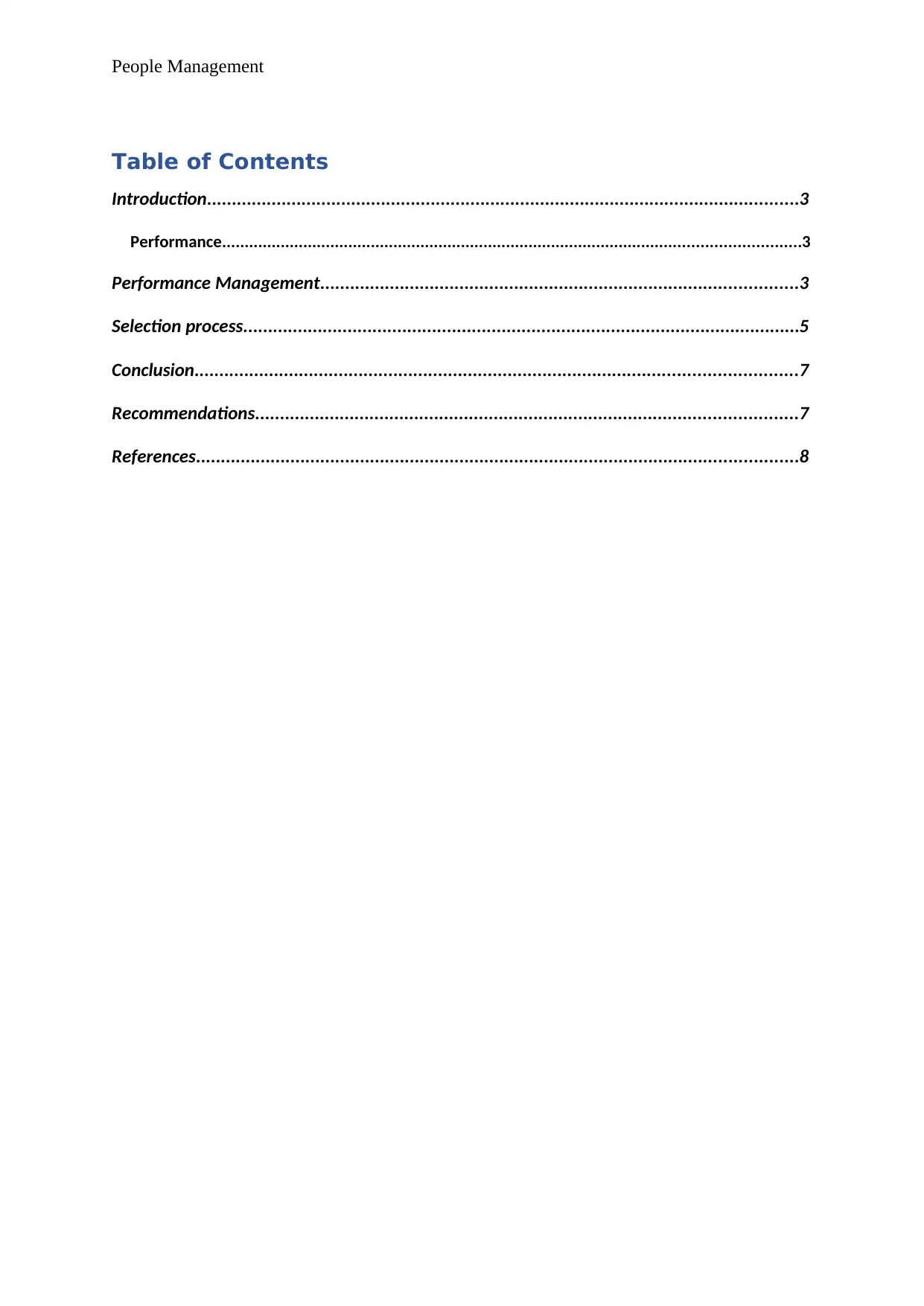
People Management
Table of Contents
Introduction.......................................................................................................................3
Performance................................................................................................................................3
Performance Management................................................................................................3
Selection process................................................................................................................5
Conclusion.........................................................................................................................7
Recommendations.............................................................................................................7
References.........................................................................................................................8
Table of Contents
Introduction.......................................................................................................................3
Performance................................................................................................................................3
Performance Management................................................................................................3
Selection process................................................................................................................5
Conclusion.........................................................................................................................7
Recommendations.............................................................................................................7
References.........................................................................................................................8
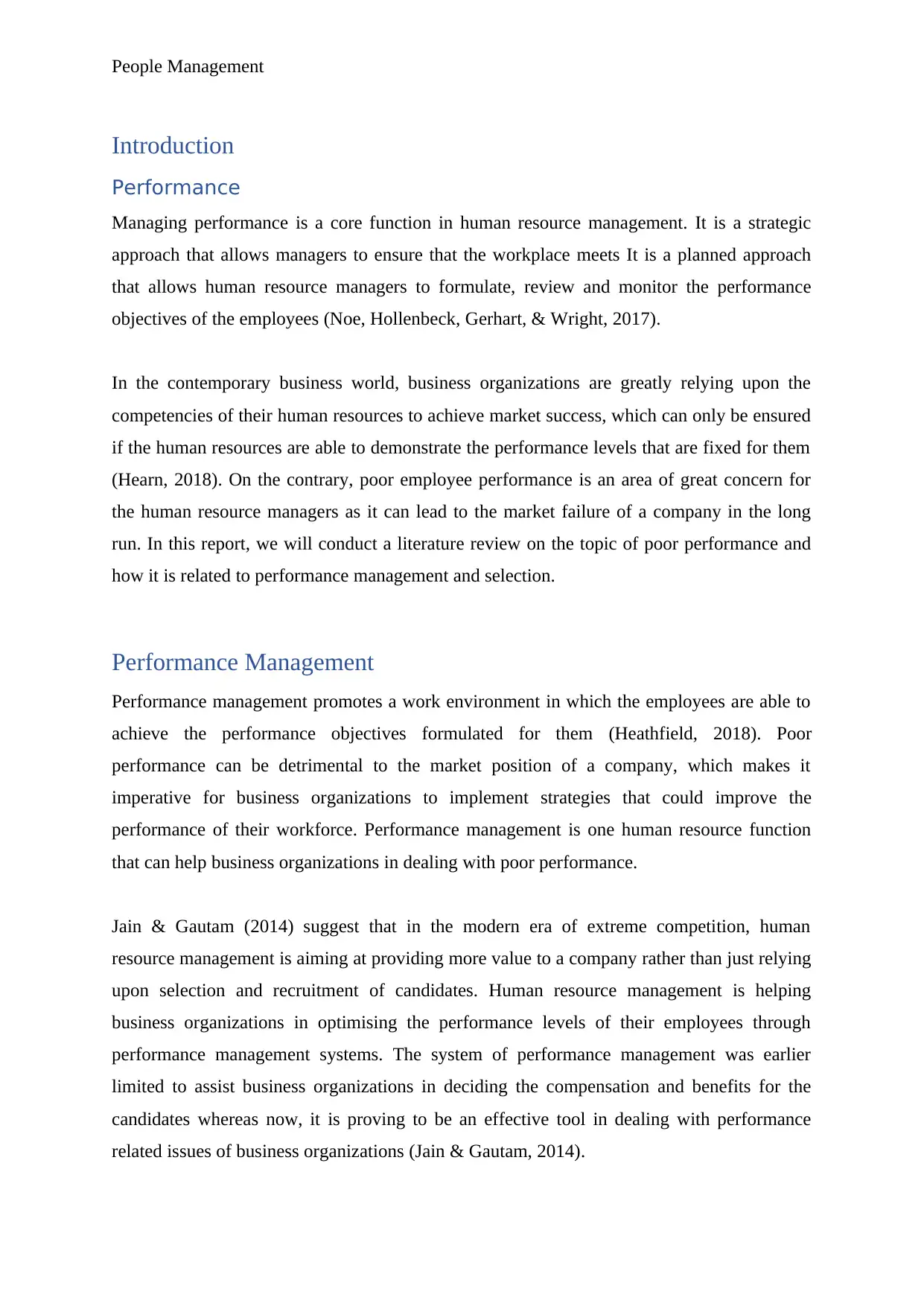
People Management
Introduction
Performance
Managing performance is a core function in human resource management. It is a strategic
approach that allows managers to ensure that the workplace meets It is a planned approach
that allows human resource managers to formulate, review and monitor the performance
objectives of the employees (Noe, Hollenbeck, Gerhart, & Wright, 2017).
In the contemporary business world, business organizations are greatly relying upon the
competencies of their human resources to achieve market success, which can only be ensured
if the human resources are able to demonstrate the performance levels that are fixed for them
(Hearn, 2018). On the contrary, poor employee performance is an area of great concern for
the human resource managers as it can lead to the market failure of a company in the long
run. In this report, we will conduct a literature review on the topic of poor performance and
how it is related to performance management and selection.
Performance Management
Performance management promotes a work environment in which the employees are able to
achieve the performance objectives formulated for them (Heathfield, 2018). Poor
performance can be detrimental to the market position of a company, which makes it
imperative for business organizations to implement strategies that could improve the
performance of their workforce. Performance management is one human resource function
that can help business organizations in dealing with poor performance.
Jain & Gautam (2014) suggest that in the modern era of extreme competition, human
resource management is aiming at providing more value to a company rather than just relying
upon selection and recruitment of candidates. Human resource management is helping
business organizations in optimising the performance levels of their employees through
performance management systems. The system of performance management was earlier
limited to assist business organizations in deciding the compensation and benefits for the
candidates whereas now, it is proving to be an effective tool in dealing with performance
related issues of business organizations (Jain & Gautam, 2014).
Introduction
Performance
Managing performance is a core function in human resource management. It is a strategic
approach that allows managers to ensure that the workplace meets It is a planned approach
that allows human resource managers to formulate, review and monitor the performance
objectives of the employees (Noe, Hollenbeck, Gerhart, & Wright, 2017).
In the contemporary business world, business organizations are greatly relying upon the
competencies of their human resources to achieve market success, which can only be ensured
if the human resources are able to demonstrate the performance levels that are fixed for them
(Hearn, 2018). On the contrary, poor employee performance is an area of great concern for
the human resource managers as it can lead to the market failure of a company in the long
run. In this report, we will conduct a literature review on the topic of poor performance and
how it is related to performance management and selection.
Performance Management
Performance management promotes a work environment in which the employees are able to
achieve the performance objectives formulated for them (Heathfield, 2018). Poor
performance can be detrimental to the market position of a company, which makes it
imperative for business organizations to implement strategies that could improve the
performance of their workforce. Performance management is one human resource function
that can help business organizations in dealing with poor performance.
Jain & Gautam (2014) suggest that in the modern era of extreme competition, human
resource management is aiming at providing more value to a company rather than just relying
upon selection and recruitment of candidates. Human resource management is helping
business organizations in optimising the performance levels of their employees through
performance management systems. The system of performance management was earlier
limited to assist business organizations in deciding the compensation and benefits for the
candidates whereas now, it is proving to be an effective tool in dealing with performance
related issues of business organizations (Jain & Gautam, 2014).
⊘ This is a preview!⊘
Do you want full access?
Subscribe today to unlock all pages.

Trusted by 1+ million students worldwide
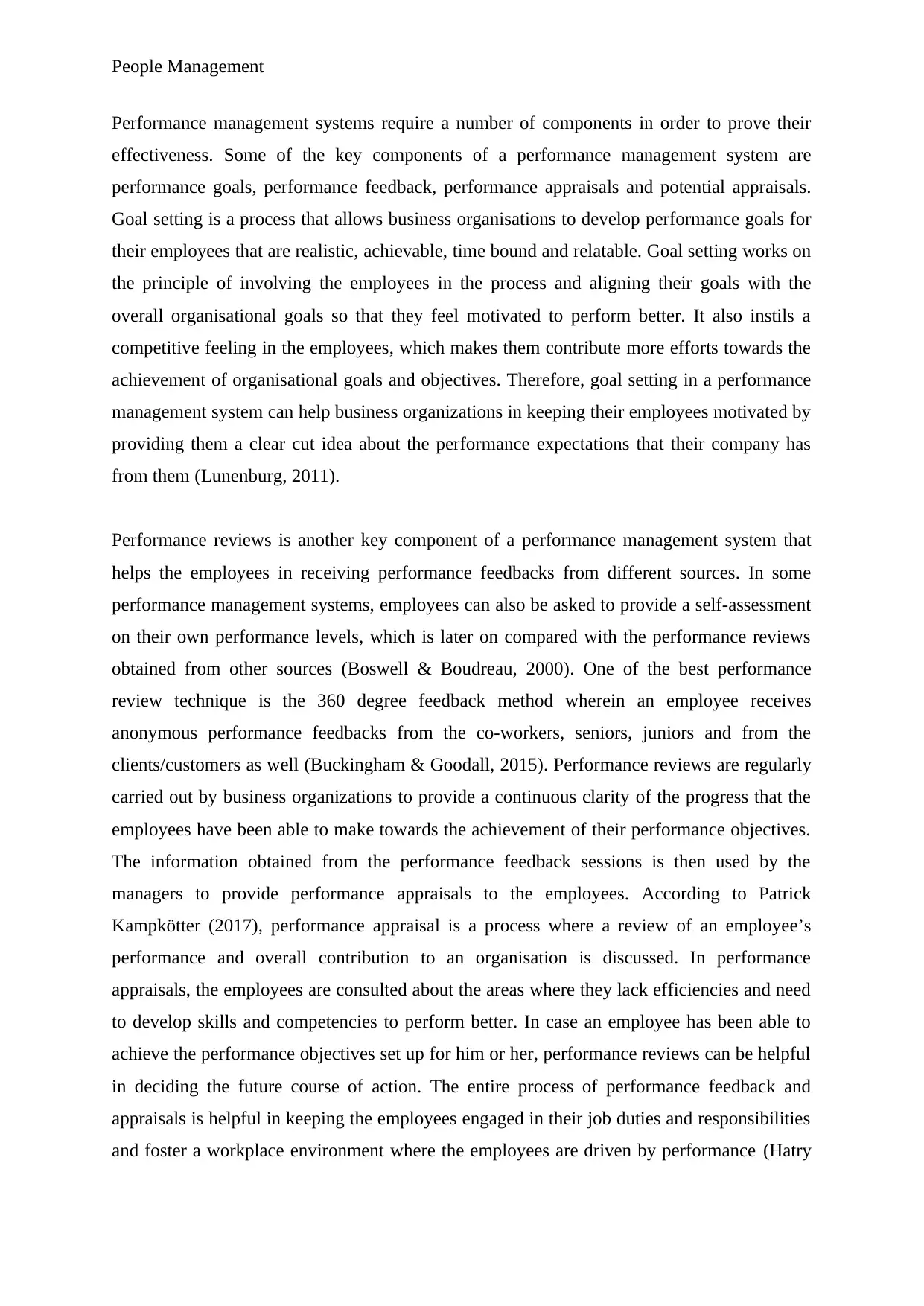
People Management
Performance management systems require a number of components in order to prove their
effectiveness. Some of the key components of a performance management system are
performance goals, performance feedback, performance appraisals and potential appraisals.
Goal setting is a process that allows business organisations to develop performance goals for
their employees that are realistic, achievable, time bound and relatable. Goal setting works on
the principle of involving the employees in the process and aligning their goals with the
overall organisational goals so that they feel motivated to perform better. It also instils a
competitive feeling in the employees, which makes them contribute more efforts towards the
achievement of organisational goals and objectives. Therefore, goal setting in a performance
management system can help business organizations in keeping their employees motivated by
providing them a clear cut idea about the performance expectations that their company has
from them (Lunenburg, 2011).
Performance reviews is another key component of a performance management system that
helps the employees in receiving performance feedbacks from different sources. In some
performance management systems, employees can also be asked to provide a self-assessment
on their own performance levels, which is later on compared with the performance reviews
obtained from other sources (Boswell & Boudreau, 2000). One of the best performance
review technique is the 360 degree feedback method wherein an employee receives
anonymous performance feedbacks from the co-workers, seniors, juniors and from the
clients/customers as well (Buckingham & Goodall, 2015). Performance reviews are regularly
carried out by business organizations to provide a continuous clarity of the progress that the
employees have been able to make towards the achievement of their performance objectives.
The information obtained from the performance feedback sessions is then used by the
managers to provide performance appraisals to the employees. According to Patrick
Kampkötter (2017), performance appraisal is a process where a review of an employee’s
performance and overall contribution to an organisation is discussed. In performance
appraisals, the employees are consulted about the areas where they lack efficiencies and need
to develop skills and competencies to perform better. In case an employee has been able to
achieve the performance objectives set up for him or her, performance reviews can be helpful
in deciding the future course of action. The entire process of performance feedback and
appraisals is helpful in keeping the employees engaged in their job duties and responsibilities
and foster a workplace environment where the employees are driven by performance (Hatry
Performance management systems require a number of components in order to prove their
effectiveness. Some of the key components of a performance management system are
performance goals, performance feedback, performance appraisals and potential appraisals.
Goal setting is a process that allows business organisations to develop performance goals for
their employees that are realistic, achievable, time bound and relatable. Goal setting works on
the principle of involving the employees in the process and aligning their goals with the
overall organisational goals so that they feel motivated to perform better. It also instils a
competitive feeling in the employees, which makes them contribute more efforts towards the
achievement of organisational goals and objectives. Therefore, goal setting in a performance
management system can help business organizations in keeping their employees motivated by
providing them a clear cut idea about the performance expectations that their company has
from them (Lunenburg, 2011).
Performance reviews is another key component of a performance management system that
helps the employees in receiving performance feedbacks from different sources. In some
performance management systems, employees can also be asked to provide a self-assessment
on their own performance levels, which is later on compared with the performance reviews
obtained from other sources (Boswell & Boudreau, 2000). One of the best performance
review technique is the 360 degree feedback method wherein an employee receives
anonymous performance feedbacks from the co-workers, seniors, juniors and from the
clients/customers as well (Buckingham & Goodall, 2015). Performance reviews are regularly
carried out by business organizations to provide a continuous clarity of the progress that the
employees have been able to make towards the achievement of their performance objectives.
The information obtained from the performance feedback sessions is then used by the
managers to provide performance appraisals to the employees. According to Patrick
Kampkötter (2017), performance appraisal is a process where a review of an employee’s
performance and overall contribution to an organisation is discussed. In performance
appraisals, the employees are consulted about the areas where they lack efficiencies and need
to develop skills and competencies to perform better. In case an employee has been able to
achieve the performance objectives set up for him or her, performance reviews can be helpful
in deciding the future course of action. The entire process of performance feedback and
appraisals is helpful in keeping the employees engaged in their job duties and responsibilities
and foster a workplace environment where the employees are driven by performance (Hatry
Paraphrase This Document
Need a fresh take? Get an instant paraphrase of this document with our AI Paraphraser
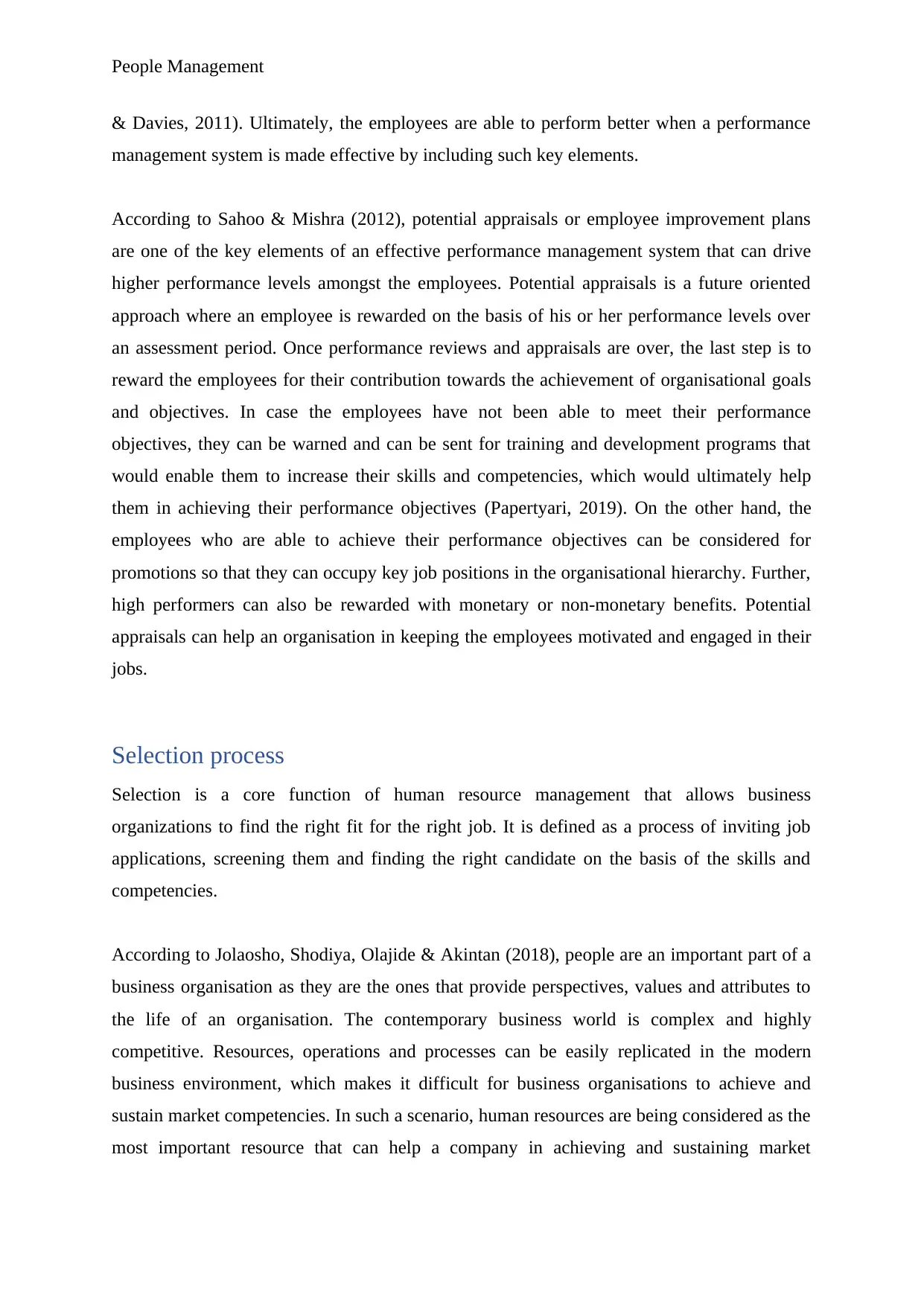
People Management
& Davies, 2011). Ultimately, the employees are able to perform better when a performance
management system is made effective by including such key elements.
According to Sahoo & Mishra (2012), potential appraisals or employee improvement plans
are one of the key elements of an effective performance management system that can drive
higher performance levels amongst the employees. Potential appraisals is a future oriented
approach where an employee is rewarded on the basis of his or her performance levels over
an assessment period. Once performance reviews and appraisals are over, the last step is to
reward the employees for their contribution towards the achievement of organisational goals
and objectives. In case the employees have not been able to meet their performance
objectives, they can be warned and can be sent for training and development programs that
would enable them to increase their skills and competencies, which would ultimately help
them in achieving their performance objectives (Papertyari, 2019). On the other hand, the
employees who are able to achieve their performance objectives can be considered for
promotions so that they can occupy key job positions in the organisational hierarchy. Further,
high performers can also be rewarded with monetary or non-monetary benefits. Potential
appraisals can help an organisation in keeping the employees motivated and engaged in their
jobs.
Selection process
Selection is a core function of human resource management that allows business
organizations to find the right fit for the right job. It is defined as a process of inviting job
applications, screening them and finding the right candidate on the basis of the skills and
competencies.
According to Jolaosho, Shodiya, Olajide & Akintan (2018), people are an important part of a
business organisation as they are the ones that provide perspectives, values and attributes to
the life of an organisation. The contemporary business world is complex and highly
competitive. Resources, operations and processes can be easily replicated in the modern
business environment, which makes it difficult for business organisations to achieve and
sustain market competencies. In such a scenario, human resources are being considered as the
most important resource that can help a company in achieving and sustaining market
& Davies, 2011). Ultimately, the employees are able to perform better when a performance
management system is made effective by including such key elements.
According to Sahoo & Mishra (2012), potential appraisals or employee improvement plans
are one of the key elements of an effective performance management system that can drive
higher performance levels amongst the employees. Potential appraisals is a future oriented
approach where an employee is rewarded on the basis of his or her performance levels over
an assessment period. Once performance reviews and appraisals are over, the last step is to
reward the employees for their contribution towards the achievement of organisational goals
and objectives. In case the employees have not been able to meet their performance
objectives, they can be warned and can be sent for training and development programs that
would enable them to increase their skills and competencies, which would ultimately help
them in achieving their performance objectives (Papertyari, 2019). On the other hand, the
employees who are able to achieve their performance objectives can be considered for
promotions so that they can occupy key job positions in the organisational hierarchy. Further,
high performers can also be rewarded with monetary or non-monetary benefits. Potential
appraisals can help an organisation in keeping the employees motivated and engaged in their
jobs.
Selection process
Selection is a core function of human resource management that allows business
organizations to find the right fit for the right job. It is defined as a process of inviting job
applications, screening them and finding the right candidate on the basis of the skills and
competencies.
According to Jolaosho, Shodiya, Olajide & Akintan (2018), people are an important part of a
business organisation as they are the ones that provide perspectives, values and attributes to
the life of an organisation. The contemporary business world is complex and highly
competitive. Resources, operations and processes can be easily replicated in the modern
business environment, which makes it difficult for business organisations to achieve and
sustain market competencies. In such a scenario, human resources are being considered as the
most important resource that can help a company in achieving and sustaining market
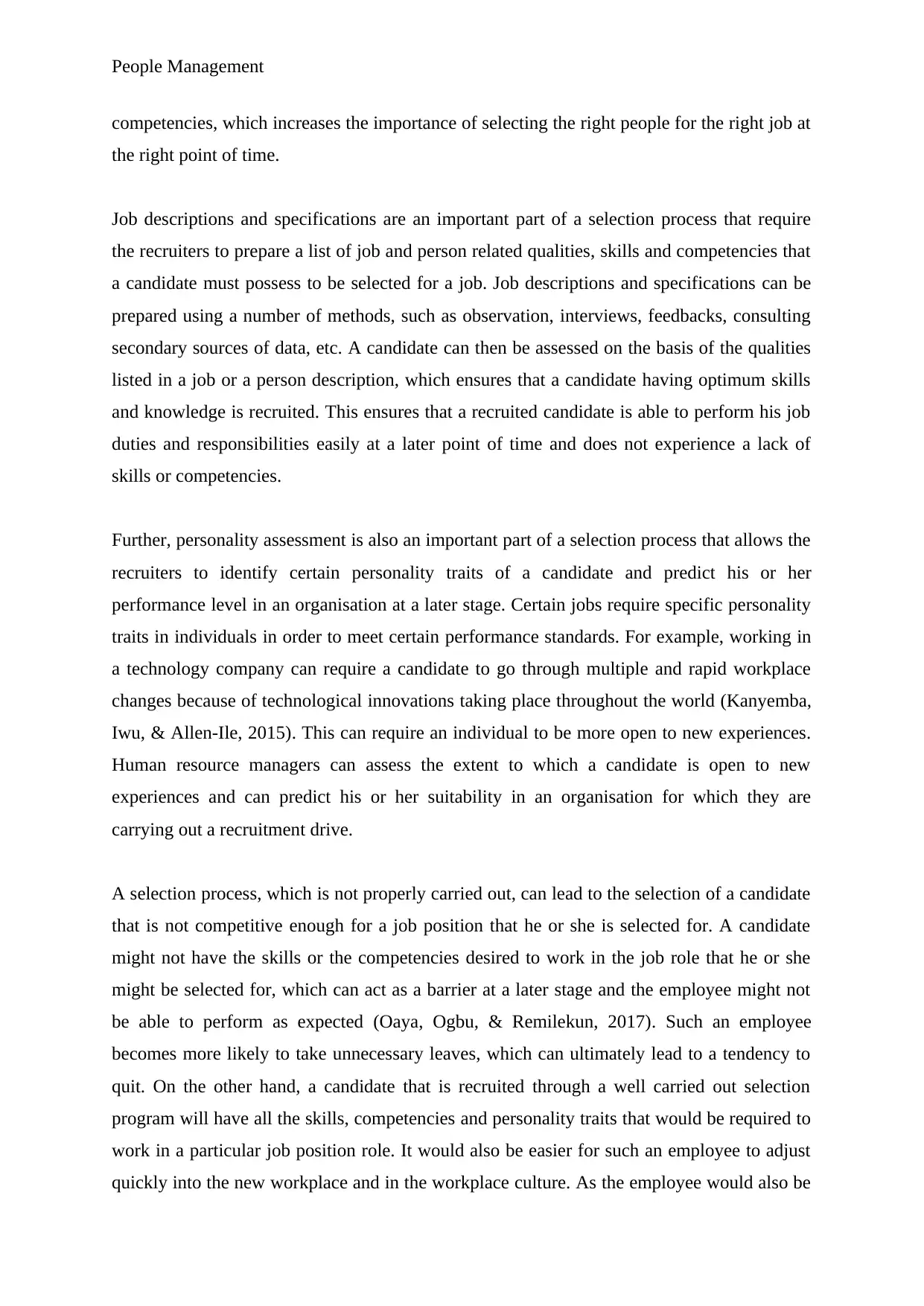
People Management
competencies, which increases the importance of selecting the right people for the right job at
the right point of time.
Job descriptions and specifications are an important part of a selection process that require
the recruiters to prepare a list of job and person related qualities, skills and competencies that
a candidate must possess to be selected for a job. Job descriptions and specifications can be
prepared using a number of methods, such as observation, interviews, feedbacks, consulting
secondary sources of data, etc. A candidate can then be assessed on the basis of the qualities
listed in a job or a person description, which ensures that a candidate having optimum skills
and knowledge is recruited. This ensures that a recruited candidate is able to perform his job
duties and responsibilities easily at a later point of time and does not experience a lack of
skills or competencies.
Further, personality assessment is also an important part of a selection process that allows the
recruiters to identify certain personality traits of a candidate and predict his or her
performance level in an organisation at a later stage. Certain jobs require specific personality
traits in individuals in order to meet certain performance standards. For example, working in
a technology company can require a candidate to go through multiple and rapid workplace
changes because of technological innovations taking place throughout the world (Kanyemba,
Iwu, & Allen-Ile, 2015). This can require an individual to be more open to new experiences.
Human resource managers can assess the extent to which a candidate is open to new
experiences and can predict his or her suitability in an organisation for which they are
carrying out a recruitment drive.
A selection process, which is not properly carried out, can lead to the selection of a candidate
that is not competitive enough for a job position that he or she is selected for. A candidate
might not have the skills or the competencies desired to work in the job role that he or she
might be selected for, which can act as a barrier at a later stage and the employee might not
be able to perform as expected (Oaya, Ogbu, & Remilekun, 2017). Such an employee
becomes more likely to take unnecessary leaves, which can ultimately lead to a tendency to
quit. On the other hand, a candidate that is recruited through a well carried out selection
program will have all the skills, competencies and personality traits that would be required to
work in a particular job position role. It would also be easier for such an employee to adjust
quickly into the new workplace and in the workplace culture. As the employee would also be
competencies, which increases the importance of selecting the right people for the right job at
the right point of time.
Job descriptions and specifications are an important part of a selection process that require
the recruiters to prepare a list of job and person related qualities, skills and competencies that
a candidate must possess to be selected for a job. Job descriptions and specifications can be
prepared using a number of methods, such as observation, interviews, feedbacks, consulting
secondary sources of data, etc. A candidate can then be assessed on the basis of the qualities
listed in a job or a person description, which ensures that a candidate having optimum skills
and knowledge is recruited. This ensures that a recruited candidate is able to perform his job
duties and responsibilities easily at a later point of time and does not experience a lack of
skills or competencies.
Further, personality assessment is also an important part of a selection process that allows the
recruiters to identify certain personality traits of a candidate and predict his or her
performance level in an organisation at a later stage. Certain jobs require specific personality
traits in individuals in order to meet certain performance standards. For example, working in
a technology company can require a candidate to go through multiple and rapid workplace
changes because of technological innovations taking place throughout the world (Kanyemba,
Iwu, & Allen-Ile, 2015). This can require an individual to be more open to new experiences.
Human resource managers can assess the extent to which a candidate is open to new
experiences and can predict his or her suitability in an organisation for which they are
carrying out a recruitment drive.
A selection process, which is not properly carried out, can lead to the selection of a candidate
that is not competitive enough for a job position that he or she is selected for. A candidate
might not have the skills or the competencies desired to work in the job role that he or she
might be selected for, which can act as a barrier at a later stage and the employee might not
be able to perform as expected (Oaya, Ogbu, & Remilekun, 2017). Such an employee
becomes more likely to take unnecessary leaves, which can ultimately lead to a tendency to
quit. On the other hand, a candidate that is recruited through a well carried out selection
program will have all the skills, competencies and personality traits that would be required to
work in a particular job position role. It would also be easier for such an employee to adjust
quickly into the new workplace and in the workplace culture. As the employee would also be
⊘ This is a preview!⊘
Do you want full access?
Subscribe today to unlock all pages.

Trusted by 1+ million students worldwide
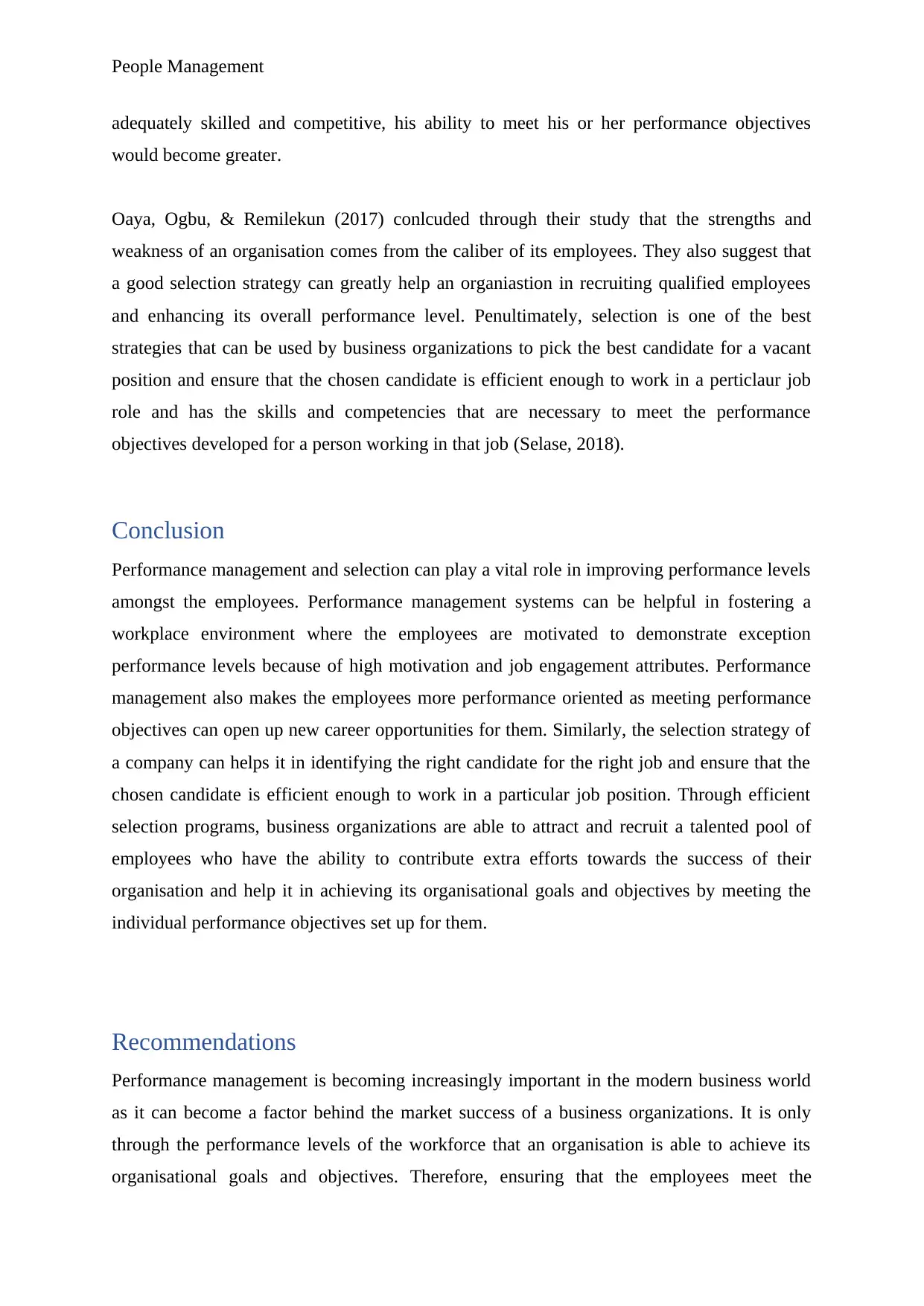
People Management
adequately skilled and competitive, his ability to meet his or her performance objectives
would become greater.
Oaya, Ogbu, & Remilekun (2017) conlcuded through their study that the strengths and
weakness of an organisation comes from the caliber of its employees. They also suggest that
a good selection strategy can greatly help an organiastion in recruiting qualified employees
and enhancing its overall performance level. Penultimately, selection is one of the best
strategies that can be used by business organizations to pick the best candidate for a vacant
position and ensure that the chosen candidate is efficient enough to work in a perticlaur job
role and has the skills and competencies that are necessary to meet the performance
objectives developed for a person working in that job (Selase, 2018).
Conclusion
Performance management and selection can play a vital role in improving performance levels
amongst the employees. Performance management systems can be helpful in fostering a
workplace environment where the employees are motivated to demonstrate exception
performance levels because of high motivation and job engagement attributes. Performance
management also makes the employees more performance oriented as meeting performance
objectives can open up new career opportunities for them. Similarly, the selection strategy of
a company can helps it in identifying the right candidate for the right job and ensure that the
chosen candidate is efficient enough to work in a particular job position. Through efficient
selection programs, business organizations are able to attract and recruit a talented pool of
employees who have the ability to contribute extra efforts towards the success of their
organisation and help it in achieving its organisational goals and objectives by meeting the
individual performance objectives set up for them.
Recommendations
Performance management is becoming increasingly important in the modern business world
as it can become a factor behind the market success of a business organizations. It is only
through the performance levels of the workforce that an organisation is able to achieve its
organisational goals and objectives. Therefore, ensuring that the employees meet the
adequately skilled and competitive, his ability to meet his or her performance objectives
would become greater.
Oaya, Ogbu, & Remilekun (2017) conlcuded through their study that the strengths and
weakness of an organisation comes from the caliber of its employees. They also suggest that
a good selection strategy can greatly help an organiastion in recruiting qualified employees
and enhancing its overall performance level. Penultimately, selection is one of the best
strategies that can be used by business organizations to pick the best candidate for a vacant
position and ensure that the chosen candidate is efficient enough to work in a perticlaur job
role and has the skills and competencies that are necessary to meet the performance
objectives developed for a person working in that job (Selase, 2018).
Conclusion
Performance management and selection can play a vital role in improving performance levels
amongst the employees. Performance management systems can be helpful in fostering a
workplace environment where the employees are motivated to demonstrate exception
performance levels because of high motivation and job engagement attributes. Performance
management also makes the employees more performance oriented as meeting performance
objectives can open up new career opportunities for them. Similarly, the selection strategy of
a company can helps it in identifying the right candidate for the right job and ensure that the
chosen candidate is efficient enough to work in a particular job position. Through efficient
selection programs, business organizations are able to attract and recruit a talented pool of
employees who have the ability to contribute extra efforts towards the success of their
organisation and help it in achieving its organisational goals and objectives by meeting the
individual performance objectives set up for them.
Recommendations
Performance management is becoming increasingly important in the modern business world
as it can become a factor behind the market success of a business organizations. It is only
through the performance levels of the workforce that an organisation is able to achieve its
organisational goals and objectives. Therefore, ensuring that the employees meet the
Paraphrase This Document
Need a fresh take? Get an instant paraphrase of this document with our AI Paraphraser
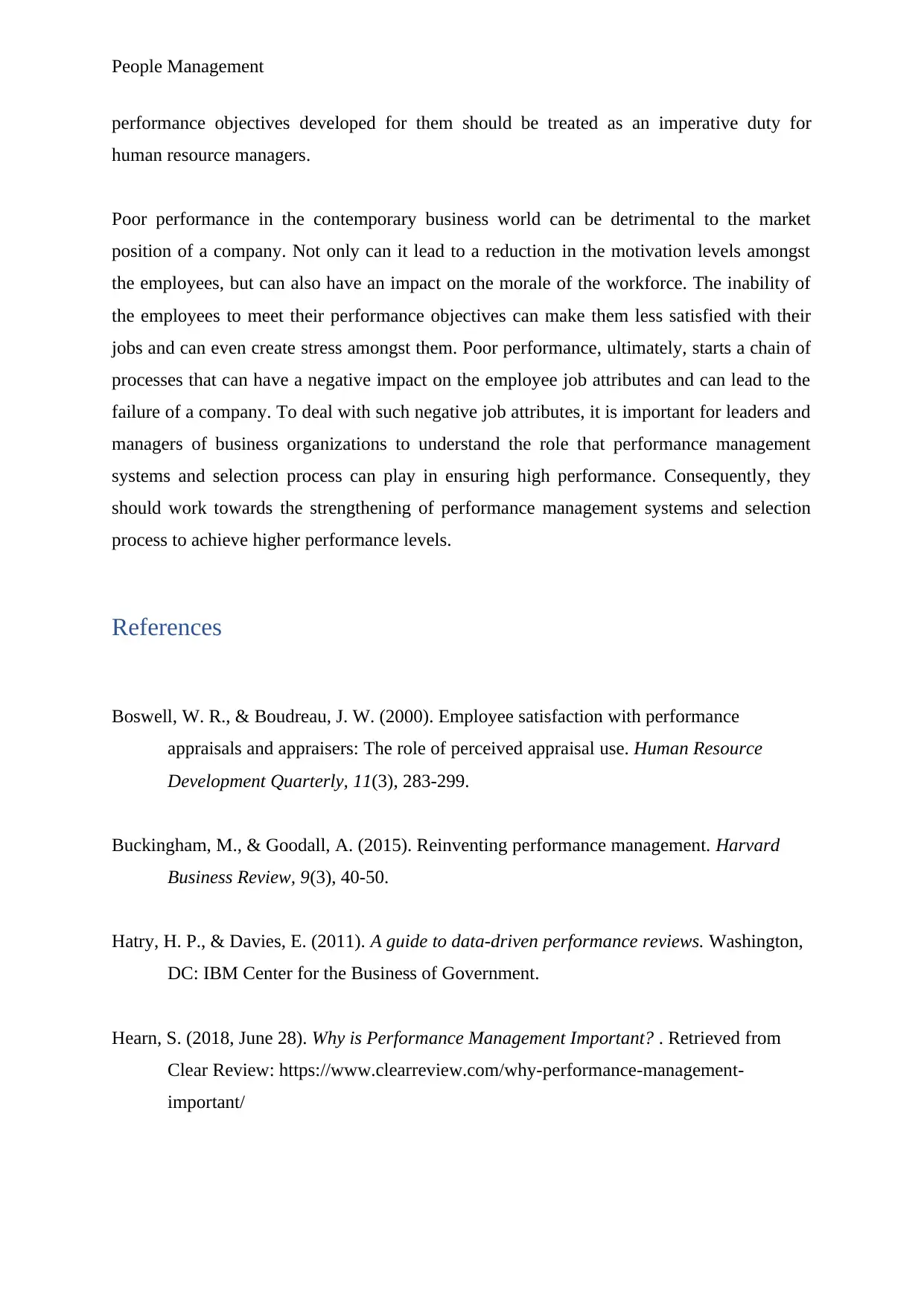
People Management
performance objectives developed for them should be treated as an imperative duty for
human resource managers.
Poor performance in the contemporary business world can be detrimental to the market
position of a company. Not only can it lead to a reduction in the motivation levels amongst
the employees, but can also have an impact on the morale of the workforce. The inability of
the employees to meet their performance objectives can make them less satisfied with their
jobs and can even create stress amongst them. Poor performance, ultimately, starts a chain of
processes that can have a negative impact on the employee job attributes and can lead to the
failure of a company. To deal with such negative job attributes, it is important for leaders and
managers of business organizations to understand the role that performance management
systems and selection process can play in ensuring high performance. Consequently, they
should work towards the strengthening of performance management systems and selection
process to achieve higher performance levels.
References
Boswell, W. R., & Boudreau, J. W. (2000). Employee satisfaction with performance
appraisals and appraisers: The role of perceived appraisal use. Human Resource
Development Quarterly, 11(3), 283-299.
Buckingham, M., & Goodall, A. (2015). Reinventing performance management. Harvard
Business Review, 9(3), 40-50.
Hatry, H. P., & Davies, E. (2011). A guide to data-driven performance reviews. Washington,
DC: IBM Center for the Business of Government.
Hearn, S. (2018, June 28). Why is Performance Management Important? . Retrieved from
Clear Review: https://www.clearreview.com/why-performance-management-
important/
performance objectives developed for them should be treated as an imperative duty for
human resource managers.
Poor performance in the contemporary business world can be detrimental to the market
position of a company. Not only can it lead to a reduction in the motivation levels amongst
the employees, but can also have an impact on the morale of the workforce. The inability of
the employees to meet their performance objectives can make them less satisfied with their
jobs and can even create stress amongst them. Poor performance, ultimately, starts a chain of
processes that can have a negative impact on the employee job attributes and can lead to the
failure of a company. To deal with such negative job attributes, it is important for leaders and
managers of business organizations to understand the role that performance management
systems and selection process can play in ensuring high performance. Consequently, they
should work towards the strengthening of performance management systems and selection
process to achieve higher performance levels.
References
Boswell, W. R., & Boudreau, J. W. (2000). Employee satisfaction with performance
appraisals and appraisers: The role of perceived appraisal use. Human Resource
Development Quarterly, 11(3), 283-299.
Buckingham, M., & Goodall, A. (2015). Reinventing performance management. Harvard
Business Review, 9(3), 40-50.
Hatry, H. P., & Davies, E. (2011). A guide to data-driven performance reviews. Washington,
DC: IBM Center for the Business of Government.
Hearn, S. (2018, June 28). Why is Performance Management Important? . Retrieved from
Clear Review: https://www.clearreview.com/why-performance-management-
important/
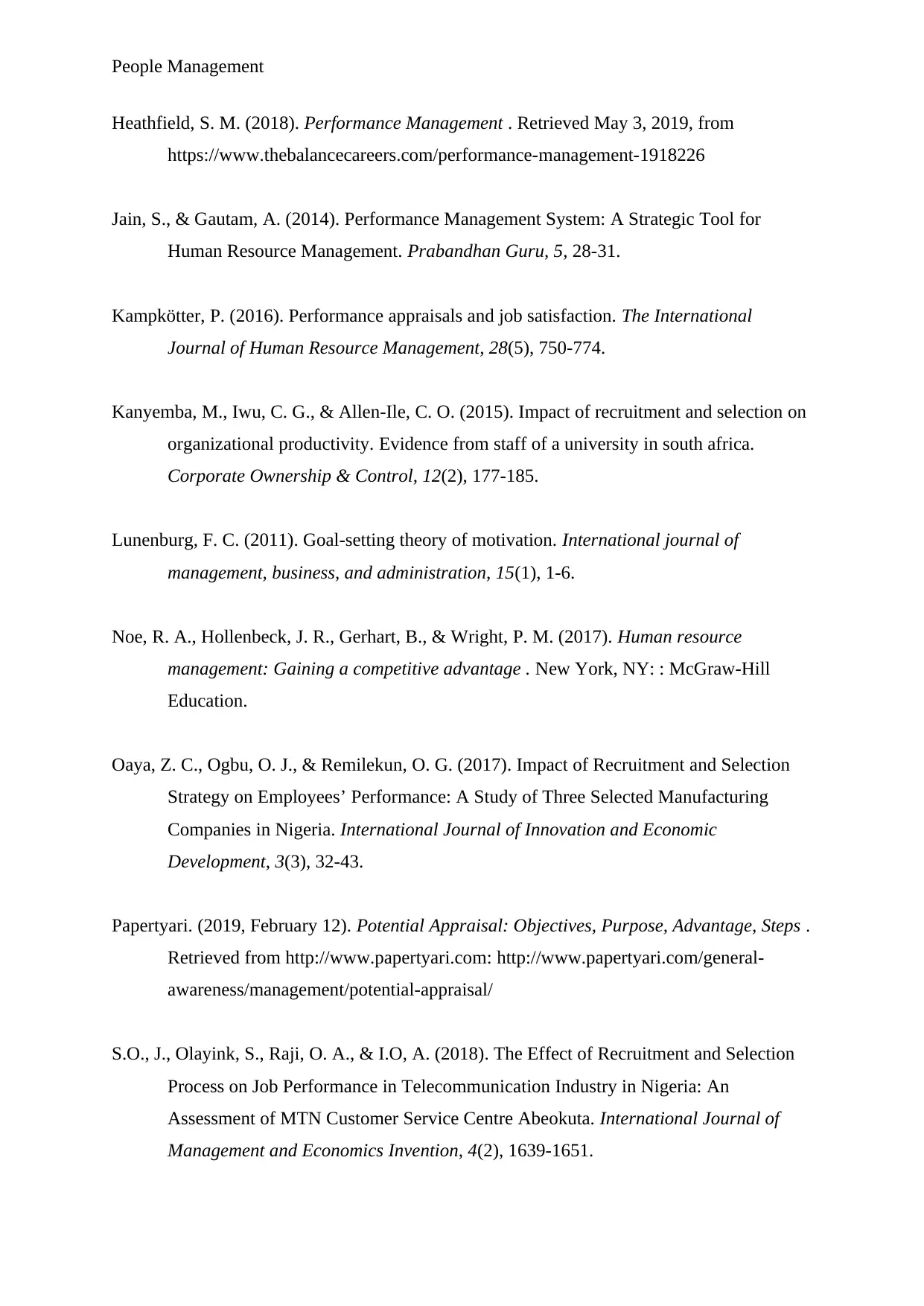
People Management
Heathfield, S. M. (2018). Performance Management . Retrieved May 3, 2019, from
https://www.thebalancecareers.com/performance-management-1918226
Jain, S., & Gautam, A. (2014). Performance Management System: A Strategic Tool for
Human Resource Management. Prabandhan Guru, 5, 28-31.
Kampkötter, P. (2016). Performance appraisals and job satisfaction. The International
Journal of Human Resource Management, 28(5), 750-774.
Kanyemba, M., Iwu, C. G., & Allen-Ile, C. O. (2015). Impact of recruitment and selection on
organizational productivity. Evidence from staff of a university in south africa.
Corporate Ownership & Control, 12(2), 177-185.
Lunenburg, F. C. (2011). Goal-setting theory of motivation. International journal of
management, business, and administration, 15(1), 1-6.
Noe, R. A., Hollenbeck, J. R., Gerhart, B., & Wright, P. M. (2017). Human resource
management: Gaining a competitive advantage . New York, NY: : McGraw-Hill
Education.
Oaya, Z. C., Ogbu, O. J., & Remilekun, O. G. (2017). Impact of Recruitment and Selection
Strategy on Employees’ Performance: A Study of Three Selected Manufacturing
Companies in Nigeria. International Journal of Innovation and Economic
Development, 3(3), 32-43.
Papertyari. (2019, February 12). Potential Appraisal: Objectives, Purpose, Advantage, Steps .
Retrieved from http://www.papertyari.com: http://www.papertyari.com/general-
awareness/management/potential-appraisal/
S.O., J., Olayink, S., Raji, O. A., & I.O, A. (2018). The Effect of Recruitment and Selection
Process on Job Performance in Telecommunication Industry in Nigeria: An
Assessment of MTN Customer Service Centre Abeokuta. International Journal of
Management and Economics Invention, 4(2), 1639-1651.
Heathfield, S. M. (2018). Performance Management . Retrieved May 3, 2019, from
https://www.thebalancecareers.com/performance-management-1918226
Jain, S., & Gautam, A. (2014). Performance Management System: A Strategic Tool for
Human Resource Management. Prabandhan Guru, 5, 28-31.
Kampkötter, P. (2016). Performance appraisals and job satisfaction. The International
Journal of Human Resource Management, 28(5), 750-774.
Kanyemba, M., Iwu, C. G., & Allen-Ile, C. O. (2015). Impact of recruitment and selection on
organizational productivity. Evidence from staff of a university in south africa.
Corporate Ownership & Control, 12(2), 177-185.
Lunenburg, F. C. (2011). Goal-setting theory of motivation. International journal of
management, business, and administration, 15(1), 1-6.
Noe, R. A., Hollenbeck, J. R., Gerhart, B., & Wright, P. M. (2017). Human resource
management: Gaining a competitive advantage . New York, NY: : McGraw-Hill
Education.
Oaya, Z. C., Ogbu, O. J., & Remilekun, O. G. (2017). Impact of Recruitment and Selection
Strategy on Employees’ Performance: A Study of Three Selected Manufacturing
Companies in Nigeria. International Journal of Innovation and Economic
Development, 3(3), 32-43.
Papertyari. (2019, February 12). Potential Appraisal: Objectives, Purpose, Advantage, Steps .
Retrieved from http://www.papertyari.com: http://www.papertyari.com/general-
awareness/management/potential-appraisal/
S.O., J., Olayink, S., Raji, O. A., & I.O, A. (2018). The Effect of Recruitment and Selection
Process on Job Performance in Telecommunication Industry in Nigeria: An
Assessment of MTN Customer Service Centre Abeokuta. International Journal of
Management and Economics Invention, 4(2), 1639-1651.
⊘ This is a preview!⊘
Do you want full access?
Subscribe today to unlock all pages.

Trusted by 1+ million students worldwide
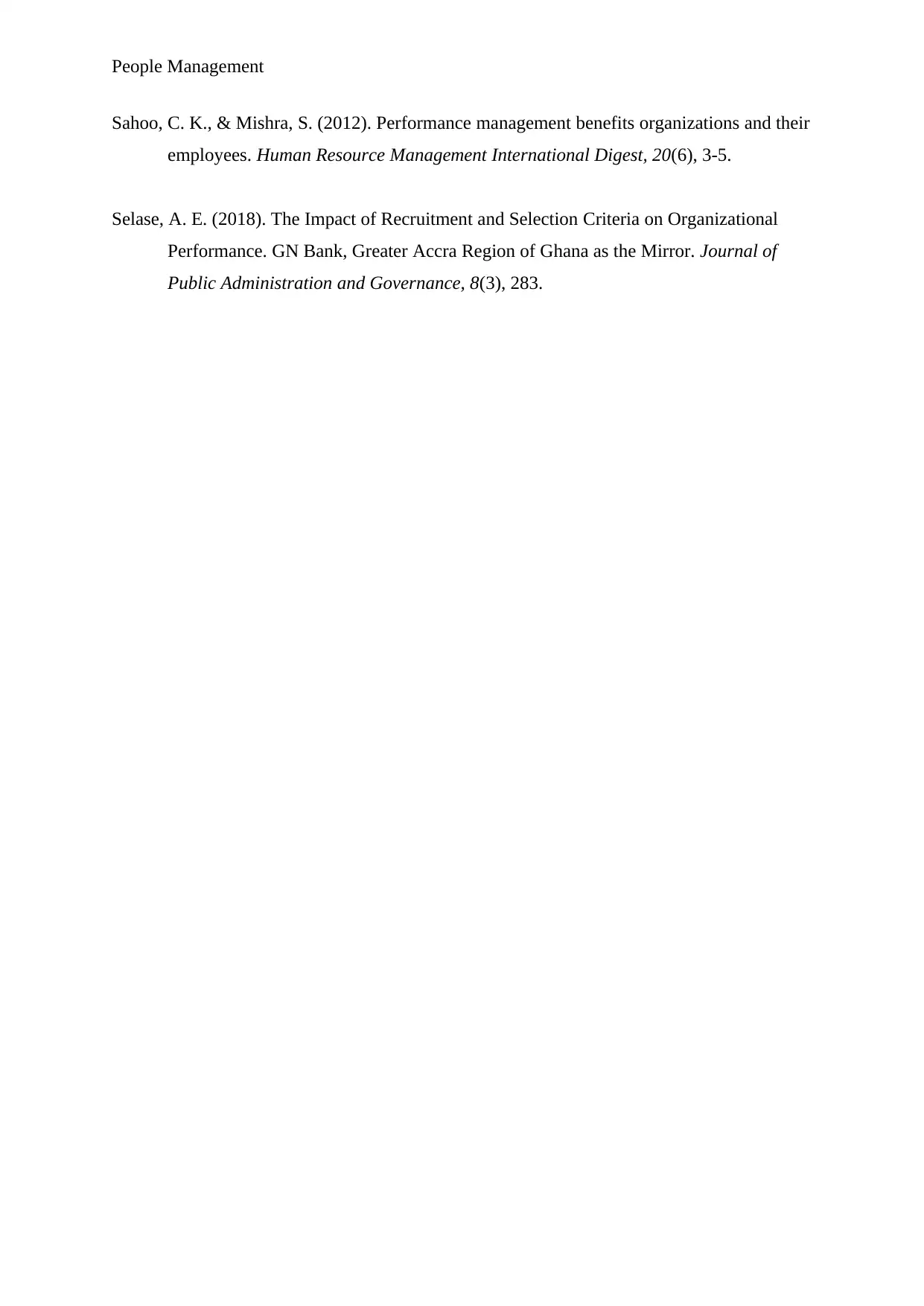
People Management
Sahoo, C. K., & Mishra, S. (2012). Performance management benefits organizations and their
employees. Human Resource Management International Digest, 20(6), 3-5.
Selase, A. E. (2018). The Impact of Recruitment and Selection Criteria on Organizational
Performance. GN Bank, Greater Accra Region of Ghana as the Mirror. Journal of
Public Administration and Governance, 8(3), 283.
Sahoo, C. K., & Mishra, S. (2012). Performance management benefits organizations and their
employees. Human Resource Management International Digest, 20(6), 3-5.
Selase, A. E. (2018). The Impact of Recruitment and Selection Criteria on Organizational
Performance. GN Bank, Greater Accra Region of Ghana as the Mirror. Journal of
Public Administration and Governance, 8(3), 283.
1 out of 10